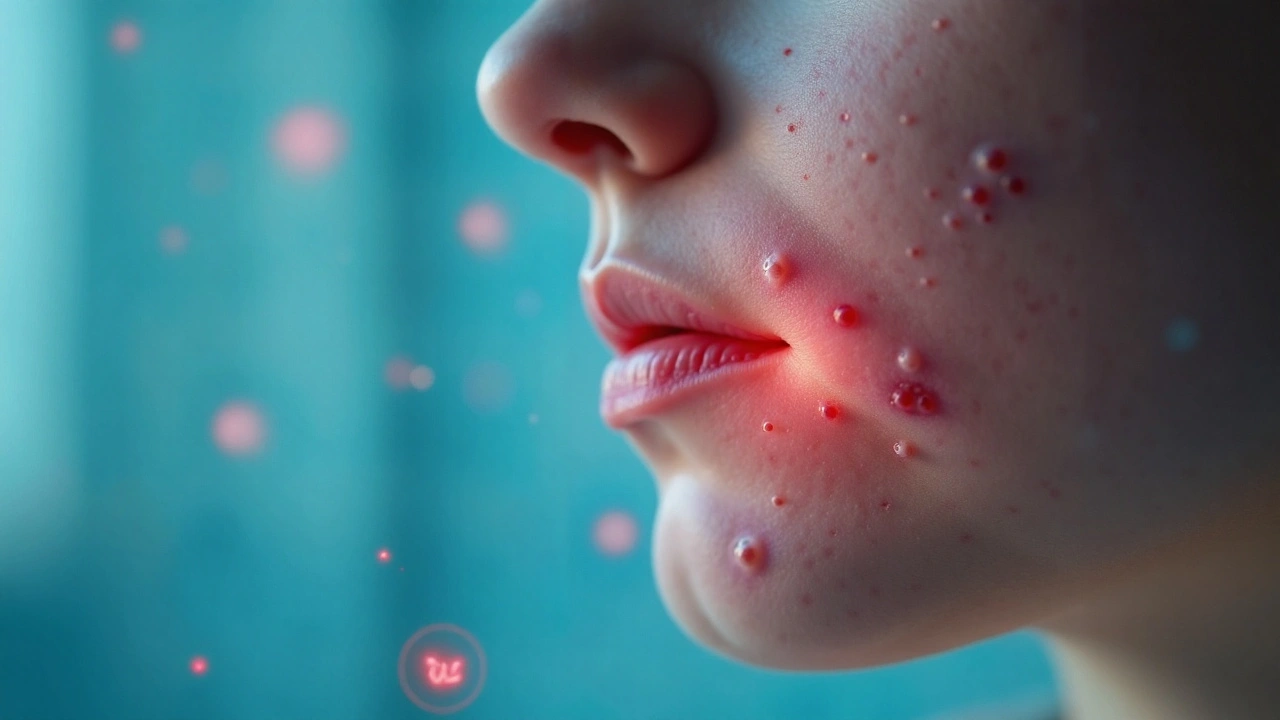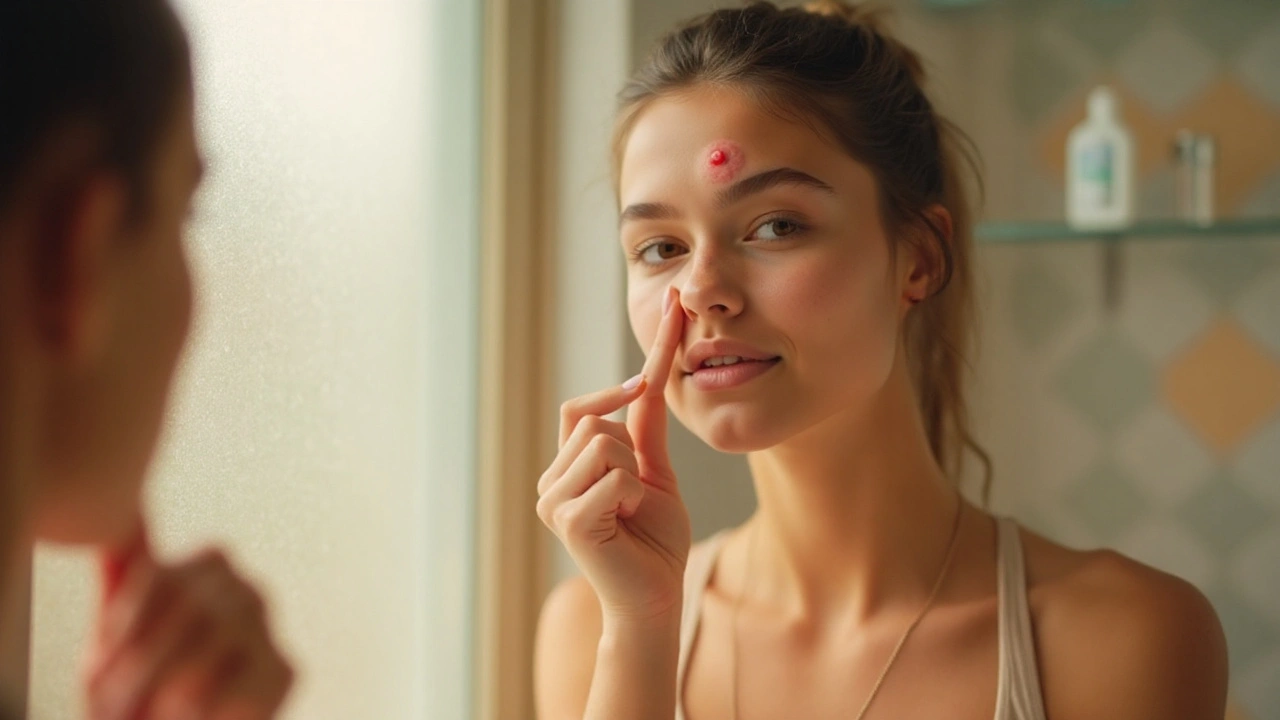Pimple is a small, inflamed bump on the skin caused by a clogged pore, excess sebum, and bacterial proliferation. While the urge to squeeze it can be strong, doing it the wrong way can turn a harmless spot into a painful, scar‑prone lesion. This guide walks you through the science behind a pop a pimple moment, tells you when to resist, and shows how to treat the skin afterward so it heals cleanly.
What Really Happens Inside a Pimple?
To decide whether a blemish is ready for extraction, you need to know its anatomy. A pore is a tiny opening that releases sebum, the oily substance that keeps skin supple. When dead skin cells and sebum mix, they can block the pore, creating a plug. Bacteria, especially Propionibacterium acnes, thrive in this environment, triggering an immune response that leads to redness and swelling.
Depending on how the plug sits, you get two common surface types:
- Whitehead - a closed comedo where the plug stays beneath the skin surface, giving a white or flesh‑colored bump.
- Blackhead - an open comedo where the plug is exposed; oxidation turns it dark.
Understanding these differences is the first step toward deciding if you should intervene.
When Is It Safe to Pop?
Not every bump deserves the same treatment. Below are three practical criteria that signal a pimple is ready for extraction:
- It has a **visible head** - the skin over the follicle is raised and the core is palpable.
- It feels **firm, not mushy** - a soft, juice‑filled lesion is still deep and likely to spread infection if squeezed.
- It is **mature**, usually 2‑3 days old - newer spots are still forming and squeezing can push contents deeper.
If any of these signs are missing, the best move is to leave the spot alone and treat it with topical care.
Step‑by‑Step: Proper Pimple Extraction
When the criteria above are met, follow this hygienic routine:
- Wash your hands with antibacterial soap for at least 20 seconds.
- Clean the affected area using a gentle cleanser, then pat dry with a clean towel.
- Apply a warm compress (a warm, damp washcloth) for 2-3 minutes. Heat softens the plug and brings it closer to the surface.
- Disinfect a comedone extractor or a sterilized needle by soaking it in 70% isopropyl alcohol for 30 seconds.
- Place the extractor’s loop around the whitehead’s head, applying gentle, even pressure. If using a needle, create a tiny opening at the very tip of the head before pressing the extractor.
- Release the pressure as soon as the plug comes out. Do not continue pressing if resistance is felt.
- Seal the spot with a dab of antibacterial ointment (e.g., 1% bacitracin) and cover with a non‑sticky bandage if needed.
- Finish by washing hands again and applying a soothing product containing salicylic acid or benzoyl peroxide to reduce inflammation.
Doing these steps under clean conditions dramatically cuts the risk of infection and scarring.
Tools & Hygiene: What You Really Need
Many people reach for a pair of tweezers or a dirty kitchen fork. Those items can introduce more bacteria. Below is a quick comparison of the most common extraction tools:
| Tool | Sanitization Requirement | Best Use Case |
|---|---|---|
| Comedone Extractor (loop) | Alcohol swab 30sec | Whiteheads & mature pustules |
| Sterile Needle (0.5mm) | Boiled & alcohol‑dipped | Opening closed comedones |
| Tweezers (stainless steel) | Alcohol swab 30sec | Removing surface debris only |
Investing in a cheap stainless‑steel extractor and keeping alcohol pads on hand is enough for most home users.

When to Leave It Alone and Opt for Other Care
Even with perfect technique, some lesions are better left untouched. Consider these scenarios:
- Deep cystic acne - large, painful nodules below the skin surface often require oral medication or professional drainage.
- Inflammated, red, tender spots that lack a defined head - squeezing will push bacteria deeper.
- Recent skin procedures (e.g., chemical peels, laser) - the skin barrier is compromised; extra pressure can cause infection.
In such cases, topical agents like niacinamide serum or a prescription‑strength retinoid can calm inflammation without the trauma of extraction.
Post‑Pop Care: Keeping Scars at Bay
After a successful extraction, the skin enters a healing phase that lasts anywhere from 3 to 7days. Follow these guidelines to minimise lasting marks:
- Apply a thin layer of silicone gel sheet after the wound has closed (usually 24hrs) - silicone has been shown to reduce scar thickness by up to 40%.
- Use sunscreen (SPF30+) daily. UV exposure darkens hyperpigmentation and makes scars more noticeable.
- Avoid touching the area with dirty hands. Even a brief poke can reignite inflammation.
- Incorporate a gentle exfoliant (e.g., 2% salicylic acid) 2-3 times a week to speed up cell turnover, but skip it for the first 48hrs post‑pop.
Healing time varies with skin type; oily skin may clear faster, while dry skin benefits from added moisturisation.
Related Concepts You Might Explore Next
If you found this guide helpful, you may also be interested in deeper topics that intersect with pimple care:
- Acne Pathogenesis - the hormonal and genetic factors that drive chronic breakouts.
- Diet and Skin Health - how sugar, dairy, and omega‑3 intake influence sebum production.
- Professional Dermatology Treatments - chemical peels, laser therapy, and prescription oral isotretinoin.
- Scarring Prevention Techniques - microneedling, laser resurfacing, and silicone therapy.
- Skin Microbiome Balance - the role of probiotic skincare in reducing inflammation.
Each of these areas offers a broader view of why breakouts happen and how to keep your complexion clear in the long run.
Frequently Asked Questions
Can I pop a pimple if it has no visible whitehead?
No. Without a defined head the plug is still deep inside the pore. Squeezing can force the bacteria further down, leading to a larger cyst or scar.
How long should I wait before trying to pop a newly formed pimple?
Wait at least 24-48hours. This allows the head to rise and the contents to become semi‑fluid, making extraction safer.
Is it okay to use a regular razor blade to cut open a whitehead?
Avoid razor blades. They are not sterilized and can cause cuts. A fine‑point sterile needle (0.5mm) is the recommended tool.
What topical ingredients help reduce inflammation after popping?
Look for products containing niacinamide, centella asiatica, or a low concentration of hydrocortisone (0.5%). These calm redness without clogging pores.
Will a silicone gel sheet really prevent scars?
Clinical studies show silicone gel applied for 12‑hours daily over 4‑6weeks can reduce scar height by 30‑50%. Consistency is key.


Ryan Spanier
Thank you for the comprehensive guide. The step‑by‑step instructions are articulated with a level of precision that is commendable. I appreciate the emphasis on hygiene, especially the recommendation to sterilize tools with isopropyl alcohol. This approach aligns well with best practices in dermatological care. Implementing these steps should markedly reduce the risk of infection and scarring.